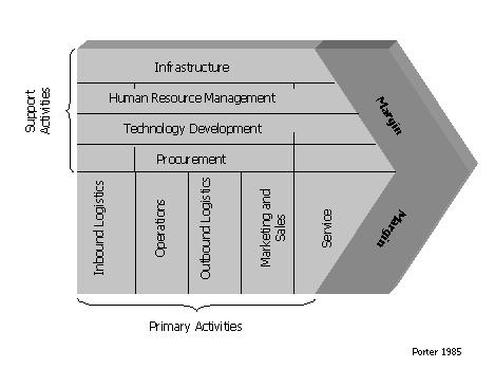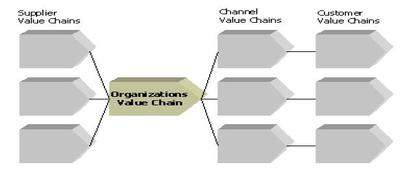THE VALUE CHAINThe term ‘Value Chain’ was used by Michael Porter in his book "Competitive Advantage: Creating and
Sustaining superior Performance" (1985). The value chain analysis describes the activities the organization performs and links them to the organizations competitive position. Value chain analysis describes the activities within and around an organization, and relates them to an analysis of the competitive strength of the organization. Therefore, it evaluates which value each particular activity adds to the organizations products or services. This idea was built upon the insight that an organization is more than a random compilation of machinery, equipment, people and money. Only if these things are arranged into systems and systematic activates it will become possible to produce something for which customers are willing to pay a price. Porter argues that the ability to perform particular activities and to manage the linkages between these activities is a source of competitive advantage. Porter distinguishes between primary activities and support activities. Primary activities are directly concerned with the creation or delivery of a product or service. They can be grouped into five main areas: inbound logistics, operations, outbound logistics, marketing and sales, and service. Each of these primary activities is linked to support activities, which help to improve their effectiveness or efficiency. There are four main areas of support activities: procurement, technology development (including R&D), human resource management, and infrastructure (systems for planning, finance, quality, information management etc.). The basic model of Porters Value Chain is as follows: The term ‚Margin’ implies that organizations realize a profit margin that depends on their ability to manage
the linkages between all activities in the value chain. In other words, the organization is able to deliver a product / service for which the customer is willing to pay more than the sum of the costs of all activities in the value chain. Some thought about the linkages between activities: These linkages are crucial for corporate success. The linkages are flows of information, goods and services, as well as systems and processes for adjusting activities. Their importance is best illustrated with some simple examples: Only if the Marketing & Sales function delivers sales forecasts for the next period to all other departments in time and in reliable accuracy, procurement will be able to order the necessary material for the correct date. Only if procurement does a good job and forwards order information to inbound logistics, only than operations will be able to schedule production in a way that guarantees the delivery of products in a timely and effective manner – as pre-determined by marketing. In the result, the linkages are about seamless cooperation and information flow between the value chain activities. In most industries, it is rather unusual that a single company performs all activities from product design, production of components, and final assembly to delivery to the final user by itself. Most often, organizations are elements of a value system or supply chain. Hence, value chain analysis should cover the whole value system in which the organization operates. Within the whole value system, there is only a certain value of profit margin available. This is the difference
of the final price the customer pays and the sum of all costs incurred with the production and delivery of the product/service (e.g. raw material, energy etc.). It depends on the structure of the value system, how this margin spreads across the suppliers, producers, distributors, customers, and other elements of the value system. Each member of the system will use its market position and negotiating power to get a higher proportion of this margin. Nevertheless, members of a value system can cooperate to improve their efficiency and to reduce their costs in order to achieve a higher total margin to the benefit of all of them (e.g. by reducing stocks in a Just-In-Time system). A typical value chain analysis can be performed in the following steps: 1. Analysis of own value chain – which costs are related to every single activity 2. Analysis of customers value chains – how does our product fit into their value chain 3. Identification of potential cost advantages in comparison with competitors 4. Identification of potential value added for the customer – how can our product add value to the customers value chain (e.g. lower costs or higher performance) – where does the customer see such potential |
|
- Home
-
Applied Analytics
-
Analytics for Decision Making
>
- What is Cluster Analysis
- Data Reduction and Unsupervised Learning
- Preparing Data and Measuring Dissimilarities
- Hierarchical and k-Means Clustering
- Defining Output Variables and Analyzing the Results
- Using Historical Data to Model Uncertainty
- Models with Correlated Uncertain Variables
- Creating and Interpreting Charts
- Using Average Values versus Simulation
- Optimization and Decision Making
- Formulating an Optimization Problem
- Developing a Spreadsheet Model
- Adding Optimization to a Spreadsheet Model
- What-if Analysis and the Sensitivity Report
- Evaluating Scenarios and Visualizing Results to Gain Practical Insights
- Digital Marketing Application of Optimization
- Advanced Models for Better Decisions
- Business Problems with Yes/No Decisions
- Formulation and Solution of Binary Optimization Problems
- Metaheuristic Optimization
- Chance Constraints and Value At Risk
- Simulation Optimization
-
Analytics for Marketing
>
- Marketing Analytics and Customer Satisfaction
- Customer Satisfaction
- Measurements and Scaling Techniques – Introduction
- Primary Scales of Measurement
- Comparative Scaling
- Non-Comparative Scaling
- Experiment Design: Controlling for Experimental Errors
- A/B Testing: Introduction
- A/B Testing: Types of Tests
- ANOVA – Introduction
- Example -Inspect Spray and Tooth Growth
- Logit Model - Binary Outome and Forecastign linear regression
- Text Summarization
- Social media Microscope
- N-Gram - Frequcy Count and phase mining
- LDA Topic Modeling
- Machine-Learned Classification and Semantic Topic Tagging
- Data Engine >
-
Customer Insights
>
- Introduction
- What is Descriptive Analytics?
- Survey Overview
- Net Promoter Score and Self-Reports
- Survey Design
- Passive Data Collection
- Media Planning
- Data Visualization
- Causal Data Collection and Summary
- Asking Predictive Questions
- Regression Analysis
- Data Set Predictions
- Probability Models
- Results and Predictions
- Perspective Analytics (Maximize Revenue and Market Structure Competitions)
-
Analytics for Advance Marketing
>
- Visualisation and statistics (Political Advertising,Movie Theater and Data Assembly)
- Excel Analysis of Motion Picture Industry Data
- Displaying Conditional Distributions
- Analyzing Qualitative Variables
- Steps in Constructing Histograms
- Common Descriptive Statistics for Quantitative Data
- Regression-Based Modeling
- Customer Analytics
- Illustrating Customer Analytics in Excel
- Customer Valuation Excel Demonstration
-
Analytics for Decision Making
>
- Soft Skills
- Marketing
- Finance
-
Economics
- JBDON Golf
- Let's Talk
- MBA Project Sharing
-
About Us
-
Good Read
>
- IIMC says PepsiCo CEO Indra Nooyi was an average student
- India’s middle class figures in Fortune’s Top Ten list of those who matter
- The Start-Up of you.
- BUYING AND MERCHANDISING
- HUMAN RESOURCE MANAGEMENT
- Do You Suffer From Decision Fatigue?
- New Page
- About social media and web 2.0
- Building Your Own Start-up Technology Company, Part 1
- Building Your Own Start-up Technology Company, Part 2
- Building Your Own Start-up Technology Company, Part 3
- Building Your Own Start-up Technology Company, Part 4
- Renewable energy is no longer alternative energy
- What Makes an Exceptional Social Media Manager?
- The Forgotten Book that Helped Shape the Modern Economy
- Home
- How to Think Creatively
- A Lighthearted Looks at Project Management and Sports Analogies
- Why Trust Matters More Than Ever for Brands
-
Good Read
>
- CET Knowledge Zone
- Untitled
- New Page
- Adidas


